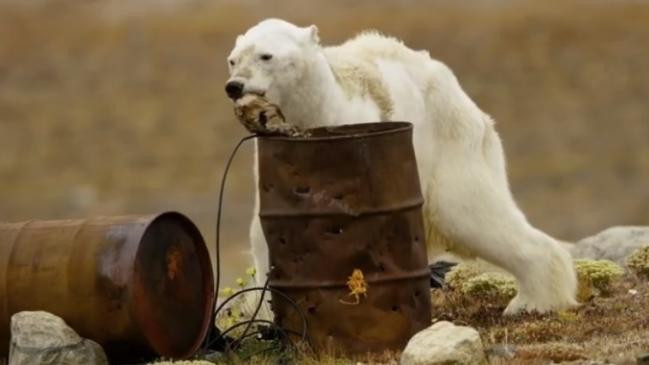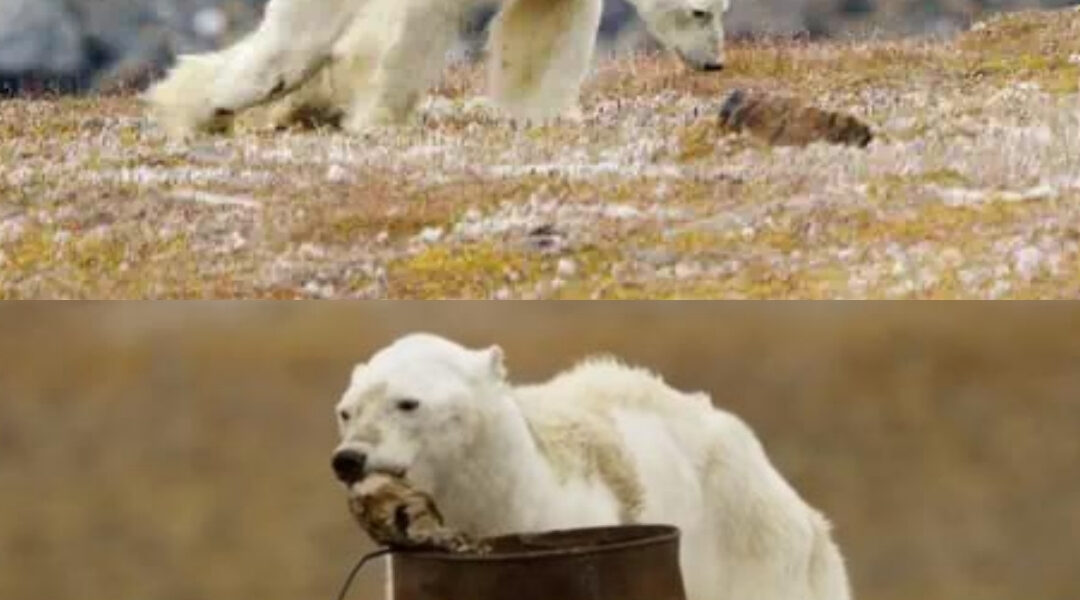When photographer Paul Nicklen rounded a rocky bend on Canada’s Baffin Islands one August afternoon, he saw what he thought was a discarded white blanket caught on the rocks. But then, the “blanket” moved. It was breathing — barely.
What lay before him wasn’t just a polar bear. It was a ghost of what a polar bear once was — skeletal, trembling, struggling to stand on legs that could no longer hold its weight. That moment, captured on camera, would soon become one of the most haunting reminders of a planet in crisis.

A Glimpse of Suffering
Nicklen, a National Geographic photographer and co-founder of the conservation group Sea Legacy, had seen wildlife in peril before. But nothing prepared him for this.
“When you see something like that, it breaks something inside you,” he said later.
He raised his camera and began filming. The bear moved slowly, its fur hanging loosely on bones, its massive frame reduced to a fragile shell. It sniffed at the ground, dragging its back legs, searching for food that wasn’t there. Every step looked like agony.
In the video, the bear is seen rummaging through a rusted garbage bin, pawing weakly at discarded items — perhaps fish scraps, perhaps nothing at all. It was a futile act of instinct: a hunter searching for life in a land where the ice, and everything it once promised, had vanished.

The Image That Shook the Internet
When Nicklen posted the footage to Instagram, it ignited the internet. Within hours, millions had watched, shared, and wept. Some called it the most painful wildlife video they’d ever seen. Others said it was the single image that made climate change real to them.
“It still haunts me,” one viewer commented. “You can’t unsee that kind of suffering.”
Nicklen’s caption read simply:
“This is what starvation looks like. This is what climate change looks like.”
His intent wasn’t shock for shock’s sake — it was a plea. A visual testament to the reality that scientists had long warned: as global temperatures rise, Arctic ice is disappearing at alarming speed, robbing polar bears of their primary hunting ground.
The Vanishing Ice
For polar bears, sea ice isn’t just a place to stand — it’s the foundation of their survival. From that frozen platform, they hunt seals, rest, and travel vast distances. But as the climate warms, the ice melts earlier each spring and refreezes later each winter.
That means fewer days to hunt, less food to build fat reserves, and longer periods of starvation on land.
When summer arrives, many bears are forced ashore, where they can find little to eat. Unlike grizzlies, they can’t simply switch diets. They evolved to live on fat-rich seal meat, not berries or carcasses.
Without ice, they are stranded — and slowly starve.
Wildlife experts estimate that polar bears number around 26,000 worldwide, but that figure could drop by more than 30% by 2050. In some regions, particularly around Hudson Bay, scientists are already seeing thinner bears, fewer cubs, and increasing deaths.

Between Hope and Controversy
As Nicklen’s video spread across the globe, it also drew criticism. Some experts cautioned that while the bear’s suffering was undeniable, there was no proof it had starved specifically due to climate change. It could have been old, injured, or sick — not every starving bear is a direct victim of melting ice.
But Nicklen never claimed certainty about that bear’s story. His point was broader — symbolic.
“We can’t say this bear died of climate change,” he acknowledged, “but we can say that this is what a world without ice looks like.”
And that message struck a nerve. For millions, the image of the emaciated bear wasn’t just about one animal’s suffering — it was about an entire planet gasping for breath.
The Human Response

The emotional power of the video sparked an outpouring of grief and action. Donations to conservation groups surged. Classrooms used the footage to teach about global warming. Politicians cited it in speeches.
Yet, for Nicklen and his team at Sea Legacy, the viral fame was bittersweet. “We didn’t film it to break hearts,” he said. “We filmed it to open them.”
Their goal wasn’t to evoke despair but to stir resolve — to make people understand that climate change is no longer a distant threat. It is happening now, and its victims are already visible.
The Story Behind the Lens
For Nicklen, who grew up in the Arctic as part of the Inuit community, this wasn’t an abstract issue. He remembers childhood days when the sea ice stretched as far as the eye could see — thick, strong, alive with movement.
“Back then, the ice would come early and stay late,” he recalled. “Now, it’s unpredictable. Some years, it barely forms at all.”
He has spent decades documenting wildlife, but he describes this bear as the most haunting image of his career.
“I cried behind the camera,” he admitted. “You don’t ever get used to seeing suffering like that. But I knew that if people could see what I saw, maybe they would care enough to act.”
The Warning Beneath the Silence

In the Arctic wilderness, death is a constant companion. But what Nicklen’s footage showed wasn’t the natural rhythm of predator and prey — it was something unnatural, a system unraveling.
When the ice disappears, so does everything built upon it — the bears, the seals, the fish, even the people who depend on those waters for food and culture. The Arctic is the planet’s early warning system. What happens there will echo everywhere.
If the ice melts completely each summer, the polar bears will be among the first to vanish — but they won’t be the last.
A Call That Still Echoes
Years later, the video of the starving bear still circulates online, reigniting debate every time it resurfaces. Some argue it manipulates emotion; others say it’s precisely what the world needs to see.
Either way, it has become a symbol — a visual shorthand for the price of indifference.
And somewhere in that haunting image, in the lonely figure of a once-mighty predator reduced to frailty, lies a question humanity can’t ignore:
If the most powerful creature of the north can no longer survive, what does that say about us?
Because the truth is simple: the bear may have died, but the warning it carried still lives.
If we look away now, one day we’ll realize that the ice — and everything it sustained — melted not just from the heat of the planet, but from the coldness of our inaction.




